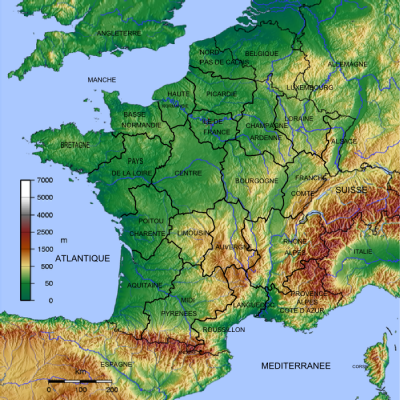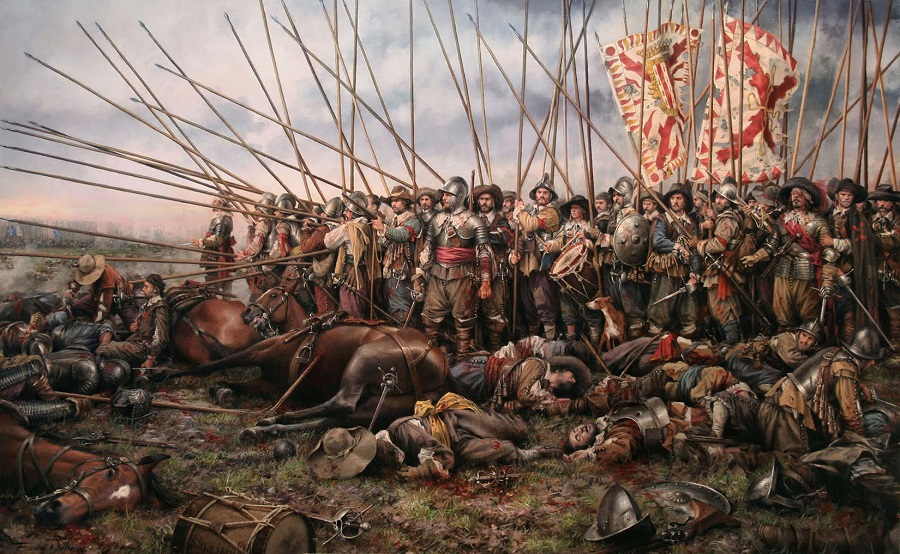
Cardinal Richelieu sees an opportunity and takes it. Continuing our series on France’s Wars. Did you ever notice that in almost every great war in history, France has been involved in some way?
SUMMARY: This war began as a religious war but ended as a conventional one over power. The Hapsburgs had it and used their successes in the religious phases of the war to grasp for more power. France decided to stop them.
DURATION: Main War: 1618-1648
Side Wars
- Spain vs. The Netherlands: 1568-1648
- Spain vs. France: 1635-1659
BACKGROUND: The Hapsburg family had risen to be the most powerful force in the World in the previous century. With Charles V (the head of the Hapsburgs), the family ruled over their personal domain (chiefly Austria and Bohemia) and the Holy Roman Empire (chiefly Germany). In 1516 he also became king of Spain, bringing the vast Spanish Empire (Mexico, Central and South America, the Caribbean Islands, Florida, and in the Orient – the Philippines) knot play. In Europe the Hapsburg ruled vast territory in Italy, Belgium, and the Netherlands. Even though after Charles abdicated in 1556 and two different individual Hapsburgs ruled the Spanish and the Holy Roman Empires, their close cooperation threatened dominance, particularly in Europe. France especially saw decades of Spanish armies moving around its kingdom, mostly to the Netherlands to prevent the Dutch bid for independence.
Despite the end of the religious conflicts of the 1500’s religious tensions remained high. In 1618 the Holy Roman Emperor decided to enforce Catholic religion throughout his domains. The Protestants resisted this policy and war commenced.
MAJOR COUNTRIES
- France
Emerging from the Religious Wars still divided and a powerful aristocracy that resisted the growing power of the central government. - Opponents
- Holy Roman Empire: Still strong after Charles V gave the Spanish Empire to another descendant, the HRE centered around the Hapsburg holdings in Central Europe. The lands in the empire not directly controlled by the emperor, were still influenced by him.
- Spain: The other branch of the Hapsburgs controlled a world-wide empire though weakened by a long-running conflict with The Netherlands.
- Allies
- Protestant Germany: This included lands both inside and outside the Holy Roman Empire. Some of their rulers were independent; some were semi-independent. All had reason to fear the power of the Empire.
- Denmark: A small kingdom which had once been a major power.
- The Netherlands: The big surprise of this era, its long war of independence from Spain had only made it stronger. It had become a major naval power and was becoming a major colonial power, too.
- Sweden: Like the other Protestant powers in this war, it did not posess the economic and population base to sustain major wars. But it had enough to produce an army big enough to compete with the major powers for a time — as long as it had a great enough leader.
- France
MAJOR LEADERS
- French
- Cardinal Richelieu: (1585-1642) was the Chief Minister to King Louis XIII.
- Cardinal Mazarin: (1602-1661) was the Chief Minister after Richelieu died.
- Turenne: (1611-1675) was one of the greatest generals of the time.
- Opponents
- Holy Roman Empire
- Ferdinand II: (1578-1537) was the Emperor.
- Frederick III: (1608-1657) was the next Emperor.
- Count of Tilly: (1559-1632) was a field marshal.
- Wallenstein: (1583-1634) was the supreme commander of the Catholic armies.
- Spain
- Holy Roman Empire
- Allies
- Protestant Germany
- Von Mansfield: (1580-1626) was a Protestant general despite being Catholic.
- Sweden
- Gustavus Adolphus: (1594-1632) was the King.
- Wrangel: (1584-1643) was a general.
- Tortensson: (1603-1651) was a field marshal and an engineer.
- Protestant Germany

CC BY-SA 3.0 image from Wikipedia.
NARRATIVE
Phase 1: The German Protestants Resist 1618: The Empire attacked and annihilated the Protestant army at in Battle of White Mountain in 1620. After that, the Imperial Army moved north overwhelming the German states in Germany.
Phase 2: Denmark Attacks 1625: The Protestant king of Denmark entered the war to drove the Empire from northern Germany. His army was defeated, then the Empire invaded Denmark
Phase 3: Sweden Attacks 1630: With Spain’s cooperation the Empire was establishing dominance in central Europe it was hit by invasion by Sweden. Sweden’s king Gustavus Adolphus brought his kingdom and his army to the status of a great power. Hin military science, he innovated the artillery. He introduced mobile artillery on the battlefield. Up to that point generals thought the bigger the cannon, the better. They planted them at the start of the battle and kept them there. Gustavus Adolphus brought smaller cannons that he could move around. He won battle after battle until he was killed at L in 16.
The Swedish army retreated and the Imperial army was once again advancing and conquering the north.
Phase 4: France Attacks 1635: Religion or power?
The religious wars had left France Catholic. The Hapsburgs of both Spain and the Empire were Catholic. They were at war with the Protestant powers of Germany, Scandinavia, and The Netherlands. Considerations of religion dictated that France support the Hapsburgs for a victory of Catholics over the Protestants.
However, a victory of the Hapsburgs would have left them dominant in western and central Europe. They could then squeeze the lands in the middle, France.
Cardinal Richelieu choose power. In 1635 France attacked. Eventually they fought on all fronts: the Netherlands, Germany, Italy and Spain.
AFTERMATH
This war ended the Hapsburg bid for dominance in Europe. The power of the Holy Roman Empire would henceforth be based on the German Branch of the Hapsburg’s own lands. Finally, Spain gave independence to The Netherlands and went into a long-term decline.
This was the last major religious war in Christian Europe. Later the powers might cite religion as a reason but with decreasing credibility. The Ottomans would continue to cite their Muslim religion as a reason for war in southeastern Europe but with the same result: decreasing credibility.
With threats from beyond its borders reduced, France was able to drop its defensive posture. It could concentrate on internal improvements consolidation and colonization. After Cardinal Mazarin’s administration, the new king, Louis XIV took direct control of the government and went from an overall defensive posture to an offensive one.
In the aftermath of the Thirty Years War, France would not only be a belligerent in the next period of wars; it would be the central mover and shaker of affairs Europe and North America.
| <—Previous | Master List | Next—> |
Further Information: here and here and below.
 |
Leave a Reply
You must be logged in to post a comment.